Why start your agile journey with us?
Several international studies have shown that organisational agility can greatly improve organisational performance. According to the Scrum.org and McKinsey 2020 survey and the international results of the State of Agile report 2023, there is a clear correlation between organisational performance and customer satisfaction and the maturity level of an agile organisation.
Agile transformation can fundamentally change the way an organisation works, so such a transformation is not an easy task. There are many paths to an agile organisation, organisations start from different levels of maturity and different "starting points", but there is one thing that all successful transformations have in common: changing the previous pattern, based mainly on hierarchy and organisational "silos", to one based on rapid learning and decision-making cycles, with a network of teams at the centre.
With the help of our experts, organisations can go beyond "doing agile" - using agile tools -, to "being agile" - apply deeper levels of agility -.
What happens after contacting us?
Ensuring ongoing leadership support is critical to the success of agile transformations, so we strive to bring our expertise to help transformations from the moment the need arises to the moment the results are realised.
1. Free consultation: understanding needs, goals, options
2. Senior management presentation, setting realistic targets
3. Preparing a high-level roadmap and proposal
4. Contracting
5. Aid within a commonly agreed scope
Our Featured Experts

Réka Pétercsák

Viktor Vései

Zsolt Czimbalmos

Áron Ulicska

Tolga Kombak

Sinan Ökek

Caner Çınar
The organisational impact of agile transformation
What difference does an agile transformation make?
The idea of an agile transformation is being raised in organisations for a reason. In a rapidly changing environment (e.g. COVID, technological changes, market and economic trends, industry regulations - to name a few examples from recent years), it is necessary to recognise the need to become more agile and to be able to respond quickly and effectively to such changes.
This change can fundamentally alter the way an organisation works, so such a transformation is not an easy task. There are many paths to an agile organisation, organisations start from different levels of maturity and different "starting points", but there is one thing that all successful transformations have in common: changing the previous model, based mainly on hierarchy and organisational "silos", to one based on rapid learning and decision-making cycles, with a network of teams at the centre.
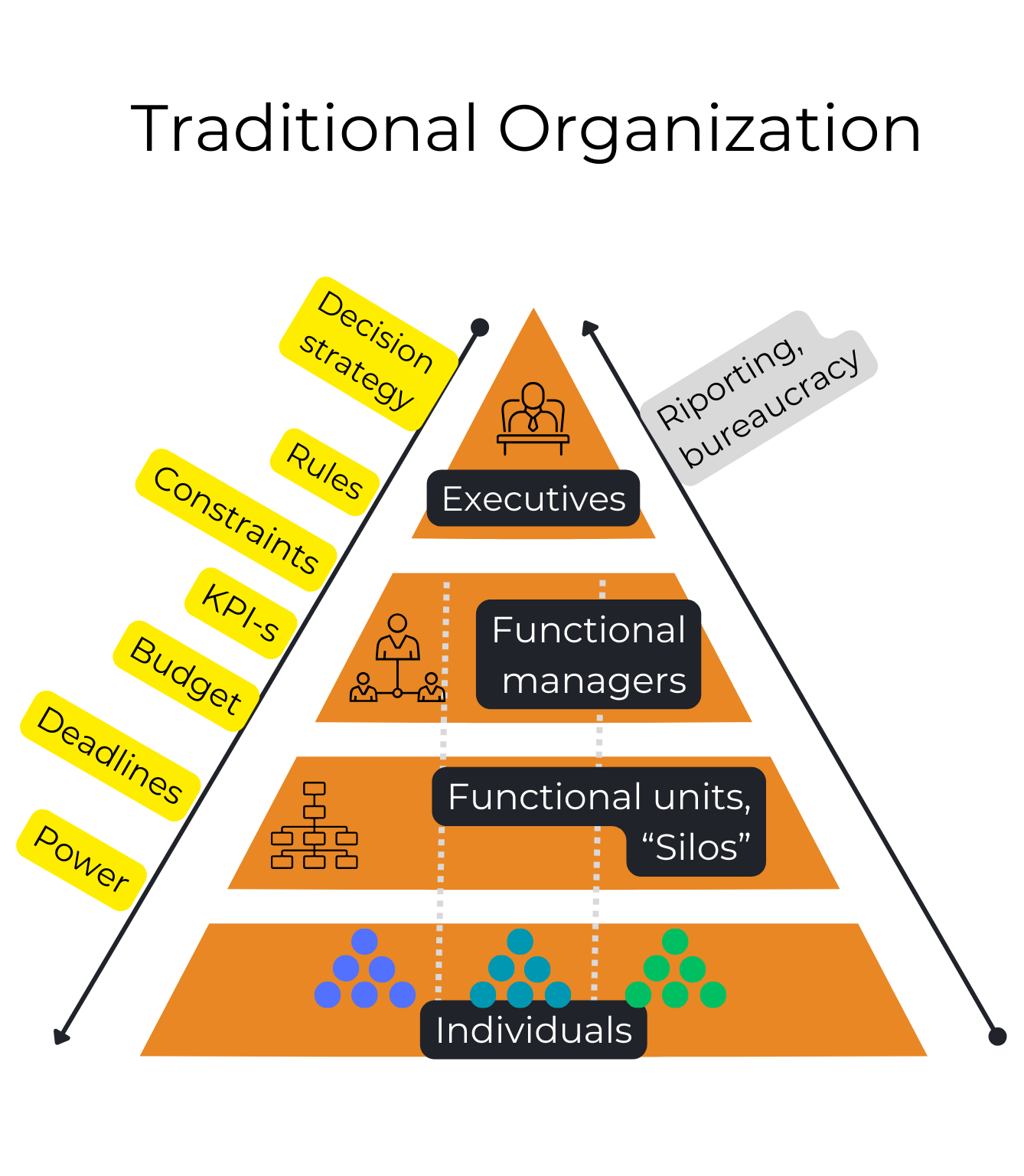
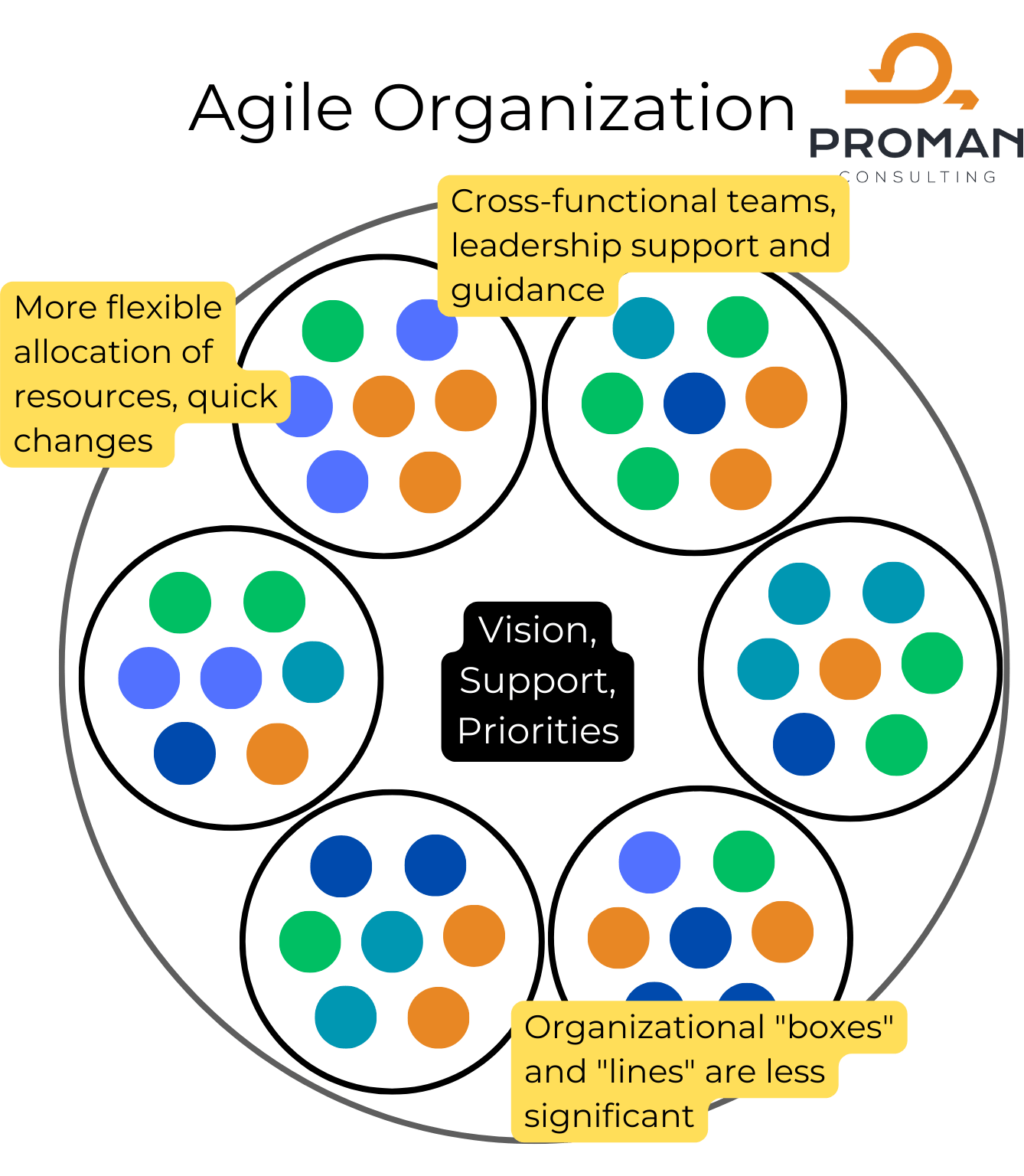
Move the slider to view before and after pictures
How do we support agile transformations?
Organizations evolve organically, so our approach is to improve corporate culture through the development of processes, the way tasks are performed, decisions are made and the interactions that accompany them. For these reasons, among others, we see agile transformation not as an organisational change management project, but rather as a "journey" in a constantly evolving task.
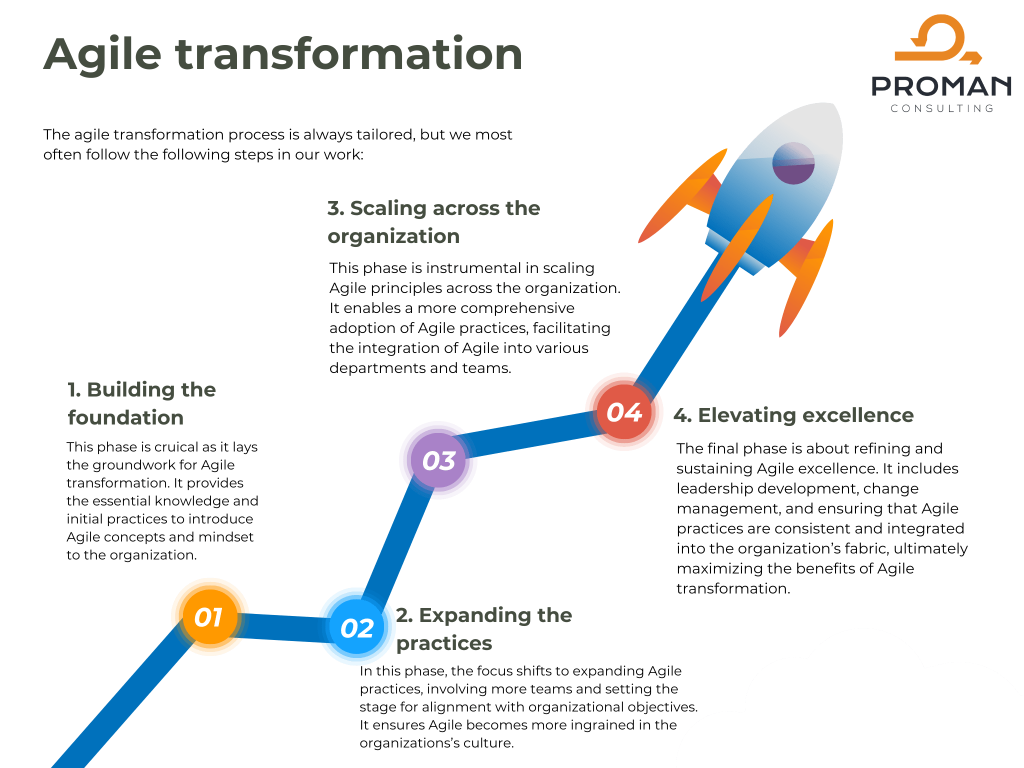
In agile transformations, we propose an evolutionary, small step-by-step transformation instead of large, simultaneous changes. This usually involves three main levels:
- Pilots - integrating working methods and tools into daily work
- Scaling tasks - Aligning strategy, measurement, operations and practices
- Improving corporate culture - developing corporate values and attitudes
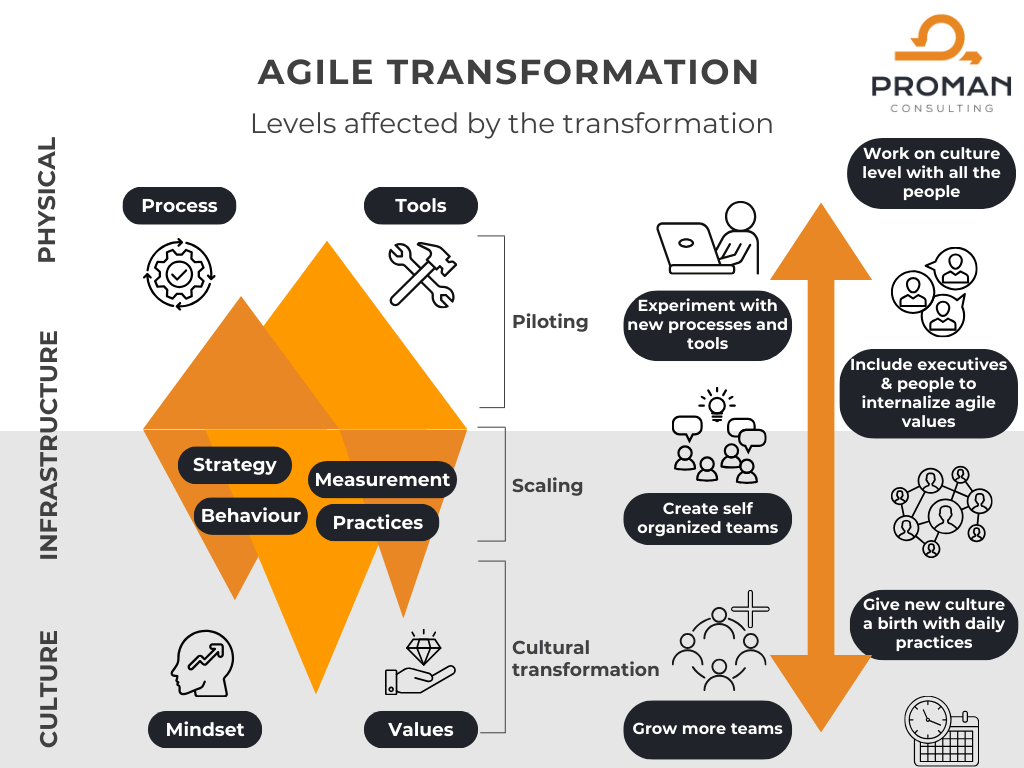
Agile Transformation roadmap
Based on our experience of previous Agile transformations we have supported, we most often support transformations by developing the following "layers", the deeper, detailed elements of which are always tailored to the organisational characteristics and features.
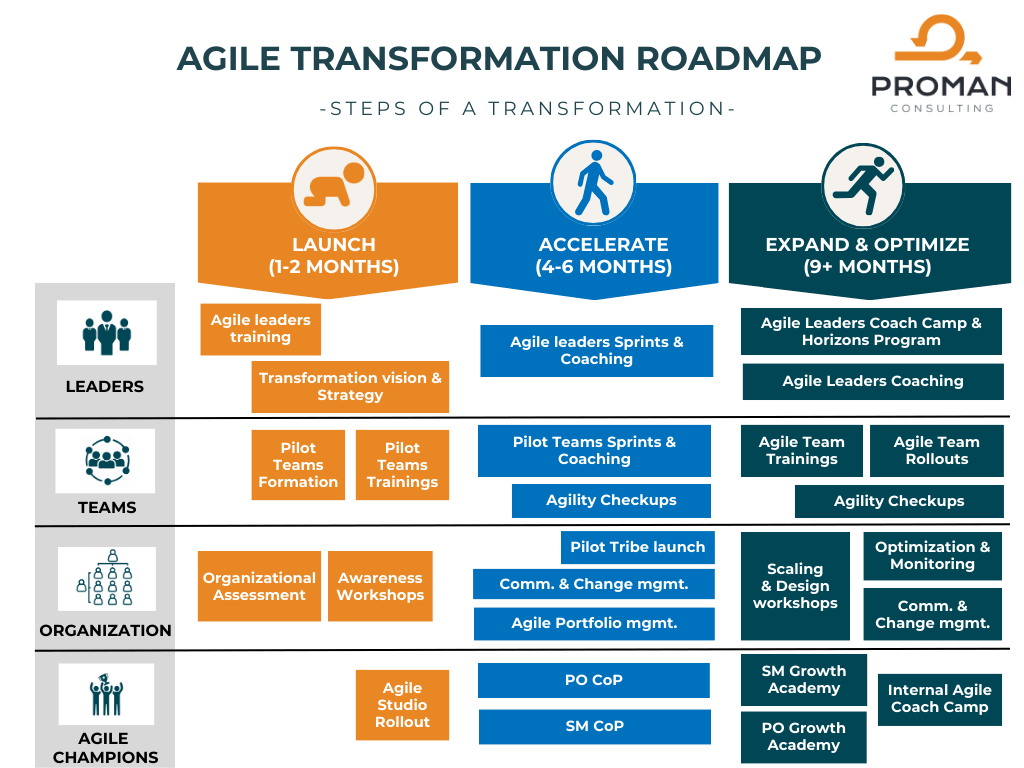
What are the layers of the agile transformation roadmap?
Leaders layer
Anyone who has been involved in a major change initiative knows that no change can happen without leadership support. This layer aims to:- the highest possible level of leadership involvement,
- to ensure that the transformation is aligned with the organisational strategy and objectives,
- and to support leaders in changes in management practices.
We support the achievement of the above most often through agile leadership training, coaching series, transformational and strategic workshops, OKR (Objectives and Key Results) development where necessary, and "agile leaders sprints" to gain first-hand experience.
Team layer
Teamwork and collaboration is an important feature of agile organisations. Our aim is to have high-performing teams in the organisation that are capable of meeting needs autonomously and to a high standard. In a larger organisation, this requires a change in working methods and mindset, which we propose to implement step-by-step. One important element of change is the launch of pilot teams, 2-6 pilot teams, depending on the size of the organisation, can gain significant experience of agile delivery. These will both be of great help in the subsequent roll-out and help to "show" to organisational stakeholders the results that this modified way of working can deliver.
During development, we support the teams with training, agile coaching and, if required, support in role selection or even the initial Scrum Master tasks and subsequent handover.
Organisation layer
In order for an organisation to truly harness the potential of agility, it is important to align the organisational framework alongside individual, team-level operations. This can often require structural changes, which can also help to weaken and break down organisational silos. By incorporating the experience gained through the pilot teams, organisational team building and organisational structure will be reshaped, building teams around organisational "value streams" or specific products and services. We follow the principle of step-by-step change here, too, we try to make the individual tribe and related teams scalable and build them up without "big-boom" transformation, with a conscious agile portfolio management and prioritisation.Agile champions layer
The transformations also aim to strengthen the characteristics of a learning organisation, which helps in continuous development. One good way to do this, in our experience, is to create "Agile Studios" and "Communities of Practices", through which the changed roles can continuously develop and share experiences, in the long run creating a circle of "Agile champions" who, as Agile coaches, will focus on the continuous improvement of the organisation without external support.
AREAS OFTEN AFFECTED BY AGILE TRANSFORMATIONS
To strengthen the above characteristics, change is most often needed. In most cases, this change is not limited to one element; in our experience, in most cases, it is appropriate to address several areas.
These elements illustrate how such a change can radically upend the life of the organisation, a process that should be undertaken very carefully. In our experience, developing the mindset is the most difficult task. We often hear that organisational culture needs to be improved. However, culture does not magically change, because it is the people who work in an organisation who shape it, consciously or unconsciously.
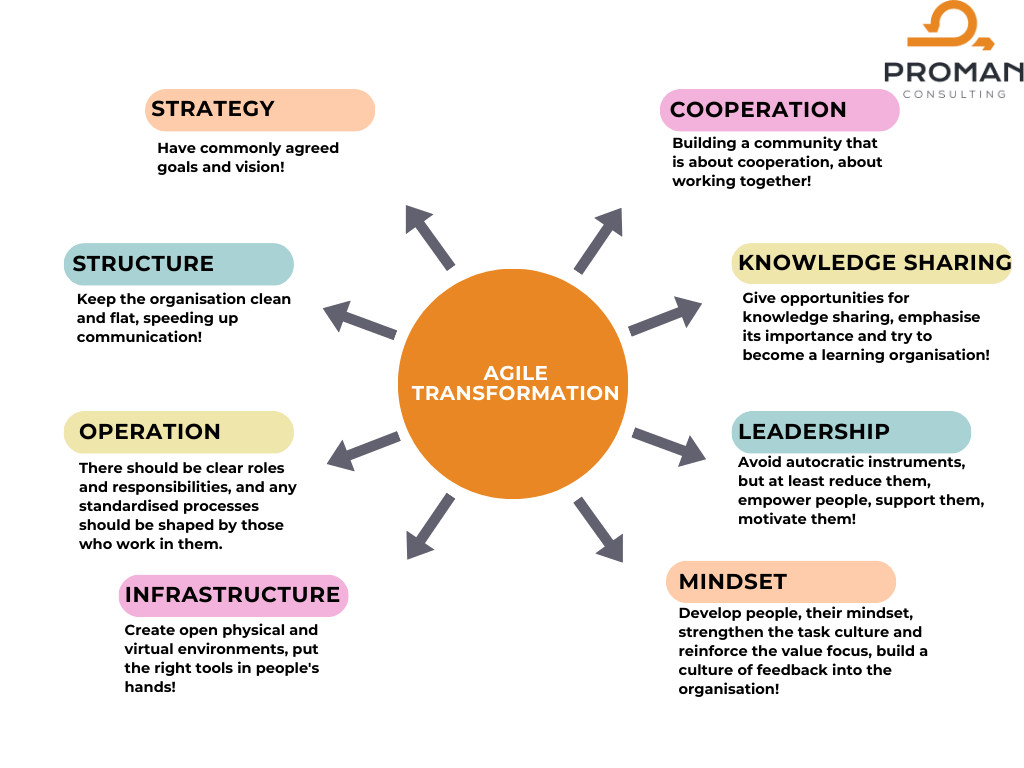
What results can we expect from an agile transformation?

Faster value delivery
The values and products delivered by the organisation get to the market faster, based on an iterative-incremental way of working. It is not possible to make miracles, but it is possible to get the results of product or service developments that are considered really important (even if they are not fully functional) into the hands of users as quickly as possible.
Higher
adaptability
Greater flexibility in scope, combined with a more rigorous approach to budgeting, will enable organisations to maintain or even increase their competitive advantage.


Customer focus
Stakeholders and teams work towards a common goal, with a primary focus on the unmet needs of customers that are constantly emerging. The teams adopt a "How about if we try it this way..." approach instead of "We can't do it because...".
Higher
empowerment
The teams are empowered to make decisions in a decentralised way, aligned with the organisational strategy and limitations. Managers are often wary of decentralised decision-making, but experience shows that even the most command-and-control minded manager recognises that his life is made easier, with more time for the really important, strategic decisions.


Cooperation and
transparency
Shared goals most often go beyond a single organisational unit, creating an organisation where different areas can work together across organisational "silos" to achieve common results with minimal dependencies. Management control alone is replaced by a radical transparency from which all members of the organisation can learn.
Clear
Focal points
The "let's do a little bit of everything" approach is being replaced by a "relentless focus on the most important things". No more hundreds of parallel projects pretending to be making progress, real results are being achieved.

How is an agile organisation different?
Traditional Organisation | AGILE ORGANISATION |
|---|---|
Functional, silo-based structure, task delivery focus | Team-based structure, value delivery focus |
Command & Control | Collaboration & teamwork |
Micro management, directive management | Servant leaders focusing on providing service |
Annual big bang planning | Rolling wave adaptive planning |
Think big, work on details, deliver the perfect | Think big, start small, evolve |
Bottom-up reporting, assumption and forecast driven decisions | Radical transparency, data driven decisions |
Long approval procedures | Fast, local decisions |
Limited tolerance for mistakes | Experimentation and learning from mistakes are opportunities |
Mechanical and permanent structure | „Living” organisation, that changes shape in line with strategies |
Focusing on individual performance | Focusing on team-based performance |
Investor mindset | Customer oriented mindset |

 Designabc
Designabc